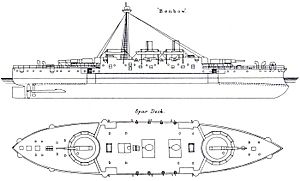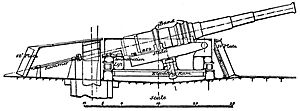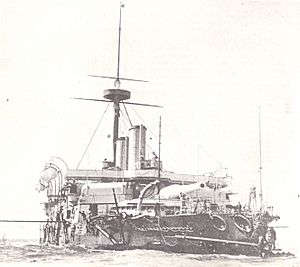HMS Benbow (1885) facts for kids

|
|
Quick facts for kids History |
|
|---|---|
| Name | HMS Benbow |
| Namesake | Admiral John Benbow |
| Builder | Thames Ironworks and Shipbuilding Co. Ltd |
| Laid down | 1 November 1882 |
| Launched | 15 June 1885 |
| Completed | June 1888 |
| Fate | Broken up, 1909 |
| General characteristics | |
| Class and type | Admiral-class battleship |
| Displacement | 10,600 tons |
| Length | 330 ft (100 m) |
| Beam | 68 ft 6 in (20.88 m) |
| Draught | 27 ft 10 in (8.48 m) |
| Propulsion | Two-shaft Maudslay compound inverted 8,658 ihp (6,456 kW) normal, 10,860 ihp (8,100 kW) forced draught |
| Speed |
|
| Complement | 523 |
| Armament |
|
| Armour |
|
HMS Benbow was a powerful battleship built for the British Royal Navy during the Victorian era. She was named after Admiral John Benbow, a famous naval officer. Completed in 1888, Benbow spent most of her time in the reserve (meaning she was kept ready but not actively used). She was eventually taken apart for scrap metal in 1909.
Designing a Battleship
HMS Benbow was very similar to two other battleships, HMS Anson and HMS Camperdown. The main difference was the type of guns she carried. The company that built her, Thames Ironworks, had to finish the ship within three years.
At that time, making very large naval guns took a long time. The guns planned for other ships in her class were 13.5 inches wide, but there weren't enough of them. So, the builders had to choose: either use smaller 12-inch guns (which were available but not as powerful as guns on foreign ships) or use the brand new, very large 16.25-inch guns.
Even though 12-inch guns could still sink any ship, the bigger 16.25-inch guns were chosen. These massive guns were placed one by one in open-topped gun positions called barbettes at each end of the ship's main deck. These were some of the largest guns ever put on a Royal Navy ship!
However, these huge guns had some downsides. They were very slow to load, taking about four to five minutes for just one shot. This meant they had less chance of hitting a moving target. Also, the front part of the gun barrel sometimes drooped, and the inside lining of the barrel only lasted for about 75 shots. Replacing this lining was a difficult and long job.
Building the Battleship
Benbow started being built at the Thames Iron Works shipyard in Blackwall on November 1, 1882. She was officially launched into the water on June 15, 1885. Catherine Gladstone, the wife of the former Prime Minister William Gladstone, had the honor of launching the ship. Benbow was finally finished and ready for service in June 1888.
Life at Sea
Benbow began her service on June 14, 1888, joining the Mediterranean Fleet. She served there until October 1891. After that, she was kept in the Reserve until March 1894, meaning she was ready for action but not actively sailing. She did take part in a few short training exercises during this time.
From 1894 until April 1904, Benbow served as a guardship at Greenock, protecting the area. In 1902, she participated in a special fleet review at Spithead to celebrate the coronation of King Edward VII. She stayed in the Reserve until 1909, when she was sold to a company named Thos. W. Ward and taken apart.




